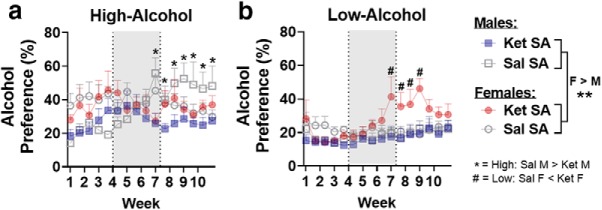Figure 6.
Ketamine decreases preference for alcohol in high-alcohol intake male rats while increasing it in low-alcohol intake females. a, b, Alcohol preference (percentage) over a 10 week period, with self-administration of ketamine or saline occurring from week 4 to 7 (indicated by shaded rectangles). a, In male rats, self-administration of ketamine (n = 8) blocks the escalation in alcohol preference observed in high-alcohol intake saline (n = 7) rats. Preference was significantly attenuated from session 18 (week 6) to 31 (week 10). In high-alcohol intake female rats, ketamine had no effect on preference (Sal, n = 7; Ket, n = 8). b, In low-alcohol intake male rats, ketamine had no effect on preference (Sal, n = 8; Ket, n = 8). In low-alcohol intake female rats, preference for alcohol was enhanced in rats that self-administered ketamine compared with saline from session 19 (week 7) to 28 (week 9; Sal, n = 8; Ket, n = 8). *p < 0.05. Data are expressed as the mean ± SEM alcohol preference.*, #p < 0.05; symbols represent either within- or between-sex differences (indicated on Fig. 5a,b), **p < 0.01.

